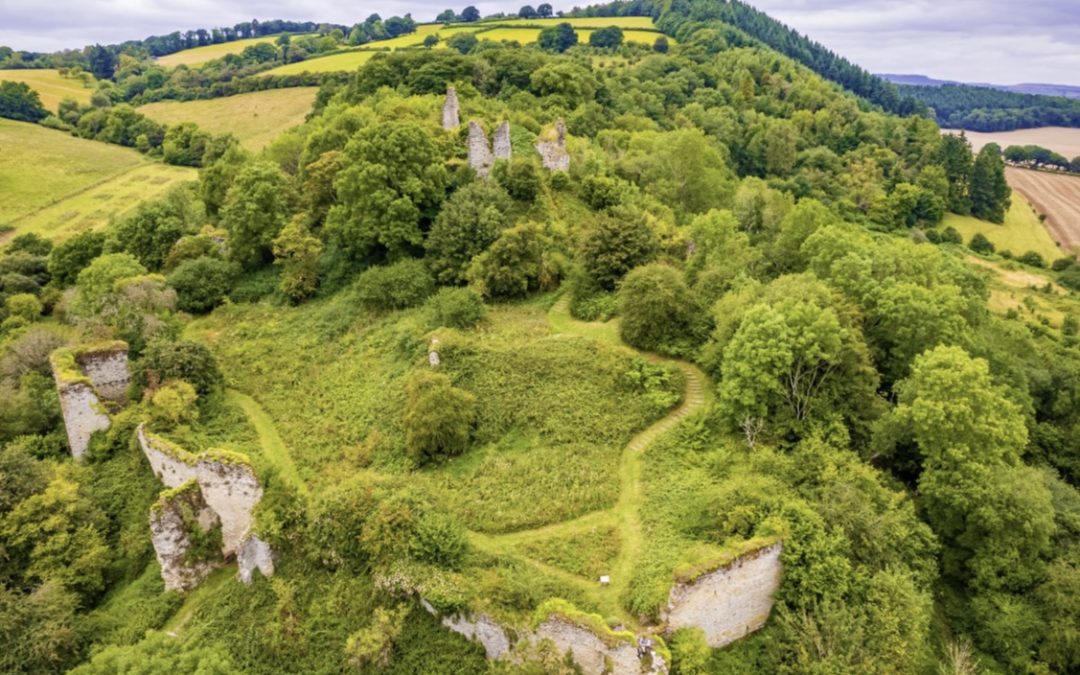A unique and rare opportunity to acquire the historic Grade I Listed Wigmore Castle and grounds with a planning consent to convert an existing workshop into a two bedroomed dwelling.
The property extends in total to about 29.84 acres (12.07 hectares).
The castle was founded in 1067 by William Fitz Osbern, Earl of Hereford and a close associate of William the Conqueror.
The Castle boasts a rich history and was a major centre of power for over 500 years hosting several kings and queens.
The proposed dwelling is located in a private yet elevated position with stunning views over the surrounding countryside and is in an easily accessible location on the edge of the rural village of Wigmore.
Wigmore is a picturesque village with a delightful blend of historical heritage, natural beauty, and a thriving local community.
There are two pub/restaurants, a community store, a mobile post office service, an active village hall, primary school and a highly regarded secondary school. Further facilities are located at nearby historic Ludlow.
Ludlow is well positioned for access to the surrounding areas with the A49 linking Shrewsbury to the North and Hereford to the South. Ludlow Train Station is on the Manchester to Cardiff line.
Barn with Planning
The existing workshop has planning consent for conversion into a two bedroomed dwelling. The workshop is located on the outskirts of Wigmore and is accessed via a private driveway leading from the A4110.
The site is bordered by agricultural land to the North and West and agricultural properties and residential properties to the East.
It is adjacent to the remains of Wigmore Castle but is not visible from them.
The site is not overlooked or visible to other properties with well-established deciduous trees and hedging. The workshop is a steel framed, timber clad barn measuring 12m x 6.0m internally.
Planning
Planning permission for conversion of the existing workshop into a detached two storey two-bedroom dwelling was granted on 23rd May 2023.
The planning decision notice and full plans are available via Herefordshire Council website under planning application code 220740.
Proposed Accommodation
The planning consent granted offers the opportunity to create a stunning conversion set in an elevated secluded position and providing accommodation which includes an open plan living area on the ground floor.
On the first floor, the consent has approved two bedrooms and a bathroom.
Wigmore Castle History
Wigmore was one of many castles built close to the England–Wales border after the Norman Conquest.
The motte and bailey castle was founded in 1067 by William Fitz Osbern. It was a major centre of power for over 500 years, and played host to several kings and queens. It was held by the Mortimer family from about 1075 to 1425, when it passed to the Crown.
The castle fell into ruin after the Civil War and remained an untouched ruin until the 1990s, when English Heritage conserved it in a way that ensured the castle’s natural environment was preserved.
It also has links to the War of the Roses because it was inherited by Richard Plantagenet, Duke of York, who returned to Wigmore in 1455 to gather a large army for the battle of St Albans against Henry VI’s forces.
Richard Plantagenet’s son, who took up his Roses cause, was crowned Edward IV after defeating Owen Tudor at the battle of Mortimer’s Cross, meaning Wigmore Castle became a royal estate. It remained in possession of the Crown until Elizabeth I sold it to Sir Thomas Harley in 1601.
However, Sir Thomas’s son was an avid supporter of Oliver Cromwell and during the Civil War his wife ordered Parliamentarian troops to dismantle the castle walls to stop it being used by Royalist forces.
Originally the castle was sited on a long, narrow ridge, ideal for defence. Its position dominates the surrounding area, overlooking the low-lying Wigmore Moor and the Roman Watling Street that crosses it. It was further strengthened with deep ditches and a series of strong walls.
It was divided into three main parts. The outer bailey, of which only earthworks remain, housed stables, granaries, and other storage buildings.
The inner bailey was defended by an H-shaped gatehouse, a deep, double ditch, and a curtain wall, which includes four surviving towers, three of them spacious. The inner bailey was the main residential area of the castle. One corner of the great hall still survives.
Above this loomed the heavily defended shell keep, with massive, 2-metre thick walls, and a tall round tower set on a motte.
To the north and west the castle was surrounded by deer parks, and nearby were fishponds, a dovecot, and a rabbit warren to provide sources of fresh fish and meat. The flatter land in the valley was farmed and about a mile to the north lay Wigmore Abbey, where the Mortimers were buried.
Further historical information is available upon request.
“A Glorious Ruin”
Wigmore now has an overgrown appearance that once characterised many ruined sites.
English Heritage describes the remains of the castle as “among the most remarkable ruins in England”. The plot also includes a moat, woodland and former jousting field.
When conserving the site in the 1990s, English Heritage deliberately retained its wildness, as the castle had become home to rare and unusual species including lesser horseshoe bats and wildflowers such as ploughman’s spikenard.
Accumulated debris was allowed to remain, and the grasses, ferns and flowers growing on the walls were carefully lifted up and replaced as ‘soft-capping’ to protect the walls from rain and more destructive plants like trees.
Land
The site extends in total to 29.84 acres (12.07 hectares) of which about 14.19 acres is permanent grassland, about 13.65 acres is mixed woodland and the remainder buildings, tracks, and grounds.
The land is classified as predominantly Grade 3.
The land is very diverse and has predominantly been kept as “managed wilderness” providing a haven for a range of wildlife. English Heritage maintain paths throughout part of the land mainly surrounding the castle to provide easy access for visitors.
The topography and nature of the land may offer additional biodiversity and natural capital opportunities.
Designations
The Castle Ruins are Grade I Listed (List Entry Number: 1178673) and part of the site is listed as a scheduled monument (List Entry Number: 1001793); the details can be found via the Historic England website.
Part of the site is also situated with the Wigmore Conservation Area and in a Local Wildlife Site; the details can be found via the following link:
https://www.herefordshire.gov.uk/directory-record/3121/wigmore-group-neighbourhood-development-plan
There is a Tree Preservation Order on a group of trees on the site consisting of 10 Elm Trees and 1 Oak Tree; the details can be found via the following link:
https://www.herefordshire.gov.uk/elections-1/administrative-map
Guardianship
Wigmore Castle ruins (coloured pink below) became a guardianship site in 1995 under the Secretary of State for National Heritage.
Any property under the guardianship of the Secretary of State must by law be made open to the public.
The Secretary of State is responsible for the maintenance of the Ancient Monument, and they have the necessary Rights of Access along the track coloured orange and yellow to carry out the maintenance and repairs as required.
Tenure
Freehold with vacant possession upon completion. The Wigmore Castle is subject to a guardianship deed further information available in the legal pack.
Services
We understated the workshop benefits from a mains electricity supply. We understand there is a mains water supply connected.
More Details – https://www.sunderlands.co.uk/residential/property/wigmore-leominster-19246015




